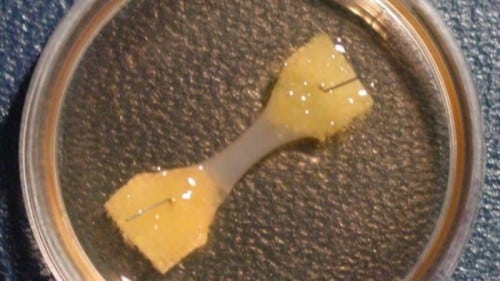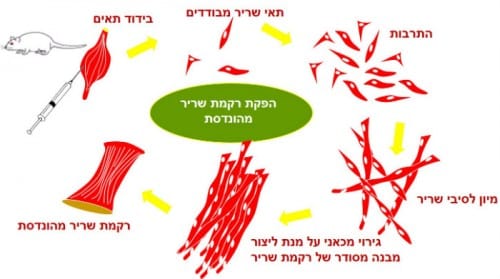Mother, you promised us a cloned chicken: the researchers of the tissue engineering laboratory in Tel Aviv are on their way to producing artificial chicken meat - a challenge that, as far as we know, no one has yet met. They will also try to overcome a long list of technical difficulties involved in growing three-dimensional tissue

The earth's population is growing rapidly, the demand for food is rising accordingly, and the environmental and economic cost of providing animal food is constantly increasing. To deal with these problems, researchers from Tel Aviv University are trying to develop a method to grow chicken breasts - in the laboratory. The researchers want to take chicken muscle cells, grow them in culture and produce a chicken breast that grows on a plate - without a chicken. The study was initiated by the association for modern agriculture, which seeks to reduce dependence on animal food, and is currently funding a feasibility study, which will examine whether it is indeed possible to grow such chicken cultures. "Assuming that one day - far in the future - we will indeed have production lines for chicken breast or any other meat from a source of tissue engineering, it's almost like creating food from nothing," says the head of the research team, Prof. Amit Gefen, from the Department of Biomedical Engineering. "When you keep cells in culture and let them divide and reproduce, biology gives us an almost inexhaustible source of food."
Many difficulties
About two years ago, researchers from the Netherlands produced the first hamburger grown in a laboratory culture. The cost of a single meatball reached a quarter of a million pounds sterling. The high price is just one issue that the researchers of the tissue engineering laboratory in Tel Aviv face, on the way to producing artificial chicken meat - a challenge that, as far as we know, no one has yet met. They will also try to overcome a long series of technical difficulties involved in growing three-dimensional tissue (see Figure 2). Normal cells are grown in culture in a single layer, and in order to create a real tissue, a kind of skeleton must be created that allows the growth of tissue with volume, as well as applying mechanical pressure (such as stretching) to obtain muscle-like tissue. On top of that, the optimal conditions for rapid growth of the cells must be found, without losing their important properties. The researchers will also try to reduce as much as possible the dependence on other animal factors.
Today, for example, animal serum is used as a main food source in the growth medium of such cell cultures. The researchers will try to find a substitute for this serum, or isolate its main components to find another source for them. Another important factor in cell cultures are growth factors - natural substances that encourage cell culture. Today, cell cultures mainly use such factors extracted from cancerous tumors, however, in edible cultures, researchers will seek to obtain growth factors from a less problematic source, or to produce artificial factors. With this, it is important to note that the cells themselves are not genetically modified. These are natural cells, which the researchers intend to engineer only their growth environment, in an attempt to meet the challenge, and grow chicken cells in culture.

The feasibility study is expected to be completed in about a year, and then the researchers will know if the chicken on a plate project has a chance to spread its wings and take off.
More of the topic in Hayadan:
- Researchers made a hamburger from cultures prepared in the laboratory. The price is 250 thousand dollars, the financier is Sergey Brin from Google
- Why are steaks still IN but hot dogs OUT?

4 תגובות
How is it that no one is yet growing female breasts in tissue cultures?
DYY!!!!!!!!!!! This is a debate!!!! Not taking, for God's sake!!! And if anything, say "let's not continue with this..." and not "bu"!!!!!!!!!! And follow and not inhibit unless you are trying to inhibit someone or something, just like her brain development was inhibited! And there's more, I'm tired.
It sounds like:
Give me twice please
What?
2 goose crab
And one cancer that.. well, that's enough, no, we'll continue with it.
Everything works on plasmids, let's hope they don't escape, at least not in the year when we make the billions
I love the word billions love to see it billions of plasmids escaping from food into our bodies
Our food will eat us in the end
Perhaps this will also one day raise the moral part of the discussion between vegans and carnivores because once the source of the meat
is not the animal species, so no more suffering will be caused to animals that are consumed by humans,
It is likely that at first there will be some reluctance to eat it but if time is likely the absolute majority of humanity will
You will switch to eating it provided of course that it will be economical, and thus most of humanity will abandon you
Eating animal meat is probably a custom that has existed for millions of years if you look at our distant relative the chimpanzee as an analogy to a common branch from which we split millions of years ago,
Regarding the issue of health, it is already more complex, not all the arguments of the claimants are sufficiently grounded and probably more used
Convince to switch to vegan eating (there may be people for whom it will be healthier, but mostly it's a matter of balance)
In addition to that, it is not certain that every vegan food is necessarily healthy, for example there is a debate even about eating a peel for example
The different types of fruit or the grain, the so-called wholemeal bread, some say that the skin has protection mechanisms against pests
that the right way to avoid them is to peel them - of course this argument is also not clear because what is harmful to the insect
It will not necessarily harm a mammal, probably hindered by the very great complexity of man, including the difference between nations and between population groups and between individuals in the population and the interaction, as in medicine, of ingredients in food with other food and different amounts
And through life, and more and more, always in every study there will be full and heated debates, each side sure that it is right and the other is wrong.